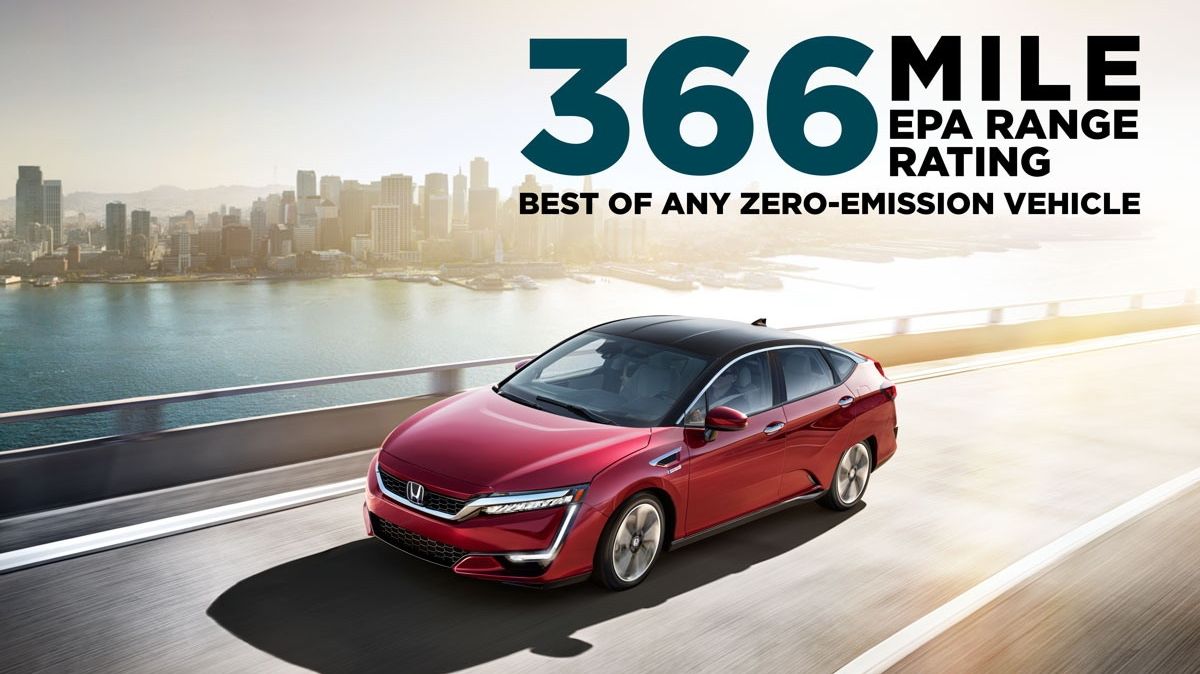Zero-emissions vehicles are more than just about the amount of horsepower they produce. The truth is, power often takes a backseat to range, or how far a zero-emissions vehicle can go on a single charge. To this day, the threshold seems to be 300 miles on a single charge, something that only a few cars are capable of achieving. One of these cars is the range-topping Tesla Model S P100D, which has a range of 315 miles. Another model that’s expected to break that mark is Honda’s Clarity fuel-cell vehicle, and according to the Japanese automaker, the Clarity FCV will have an EPA rating of 366 miles on a single tank, or the equivalent of 68 mpg combined (city and highway), making it the new standard-bearer for the highest range among zero-emission vehicles.
Do the math and the Clarity FCV can push 51 miles longer than the Model S P100D. More importantly, the Clarity FCV has 54 miles on its direct competitor, the Toyota Mirai FCV, which has a reported range of 312 miles. And let’s not even compare the equally new Chevrolet Bolt, which carries a range of 238 miles, 128 miles less than the Clarity FCV.
Having the highest range among zero-emission vehicles is an important selling point for Honda. It’s the performance car equivalent of horsepower, in large part because customers are most likely to gravitate towards cars that can last longer and farther on the road than their competitors. Considering that refuelling times for these cars are dropping with the advent of new technologies, range is quickly become one of the de facto numbers that prospective buyers will be looking for when they’re in the market for a zero-emissions vehicle.
The good news for Honda is that the Clarity FCV also comes with a number of interesting features, including Honda Sensing technology, Apple CarPlay, and Android Auto. Pricing for the car has yet to be revealed, but the most common figure being thrown around is about $60,000, a tad more expensive than the Mirai FCV.
The biggest downfall of the Clarity FCV is its limited availability. Honda is only selling it in California, matching the locations of its network of hydrogen refueling stations. Only six dealerships in Southern California, five in the Bay Area, and one in Sacramento are selling the Clarity.
Continue after the jump to read the full story.
This is a good start to Honda's plan to sell one million zero-emissions vehicles by 2030
I know it’s too early to tell if the Honda Clarity FCV will be a hot seller for Honda when it launches later this year. As important as range is, it’s still not the only determining factor in the appeal of a zero-emissions vehicle. Other factors have to be considered, including styling, power, technology, and customer appeal. There are a lot of things to consider and simply having the highest range doesn’t guarantee a lot of support from the car-buying public.
But it is a great selling point and Honda should maximize the Clarity FCV’s capabilities for all of its worth. That’s one way it can bolster its own lineup of zero-emission vehicles as it officially embarks on its goal to selling 1 million zero-emission vehicles per year in the US by 2030.
I know that goal is a long shot by any stretch of the imagination, but if Honda is going to start somewhere, it might as well be on a car that currently holds the title as having the highest range among zero-emission vehicles that are in the market today.
How Honda navigates around marketing the Clarity FCV in today’s market is also going to be crucial in determining whether the car-buying public will be receptive to the model or not. Another issue is growing the number of hydrogen refueling stations. Currently Honda's hydrogen network is limited to California, making the Clarity FCV's range sort of ironic. These are just steep hills to climb, but Honda’s on the right path. It just has to resist the temptation of promoting the Clarity FCV past its own capabilities.
Read our full review on the Honda FCV here.

